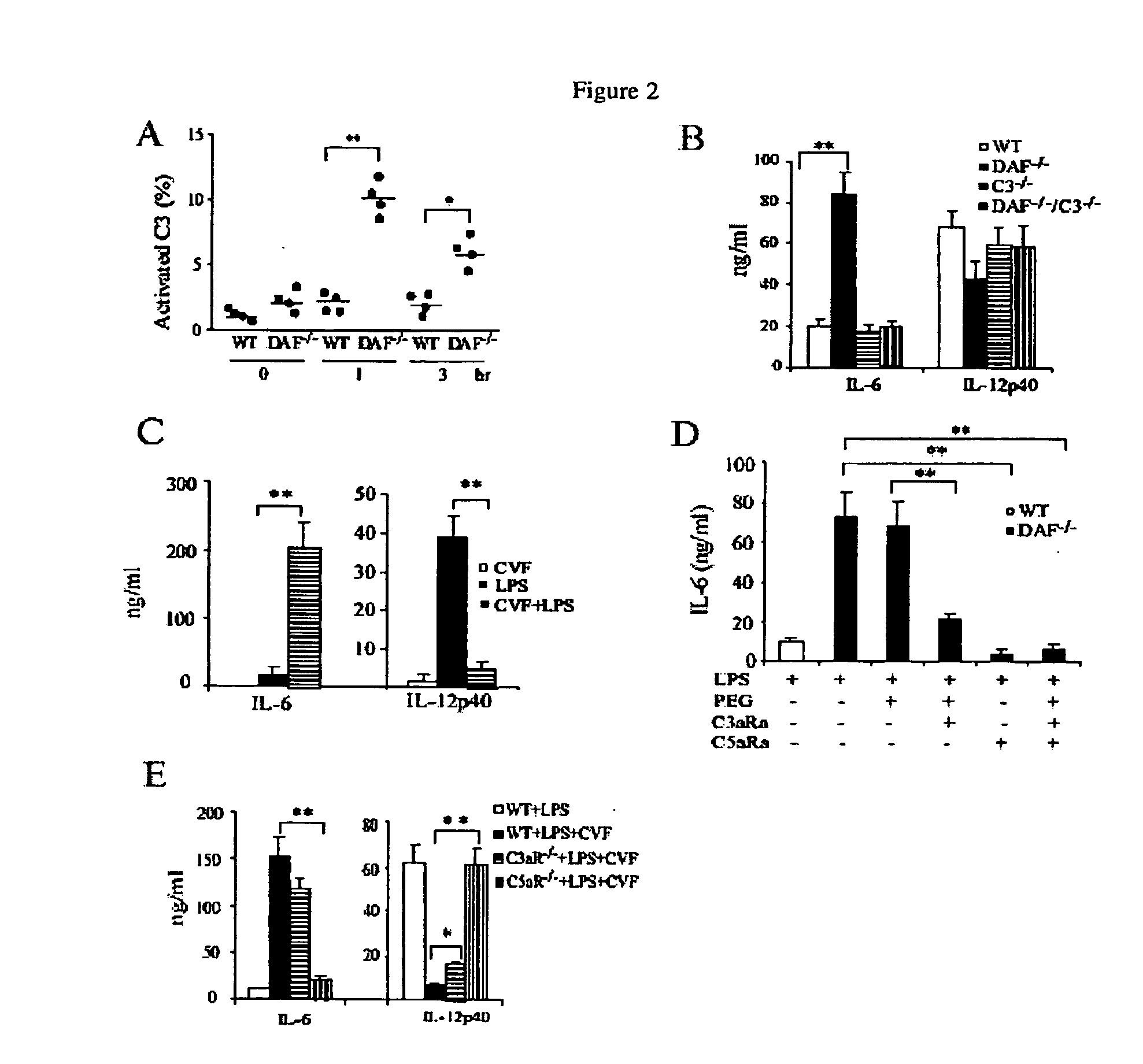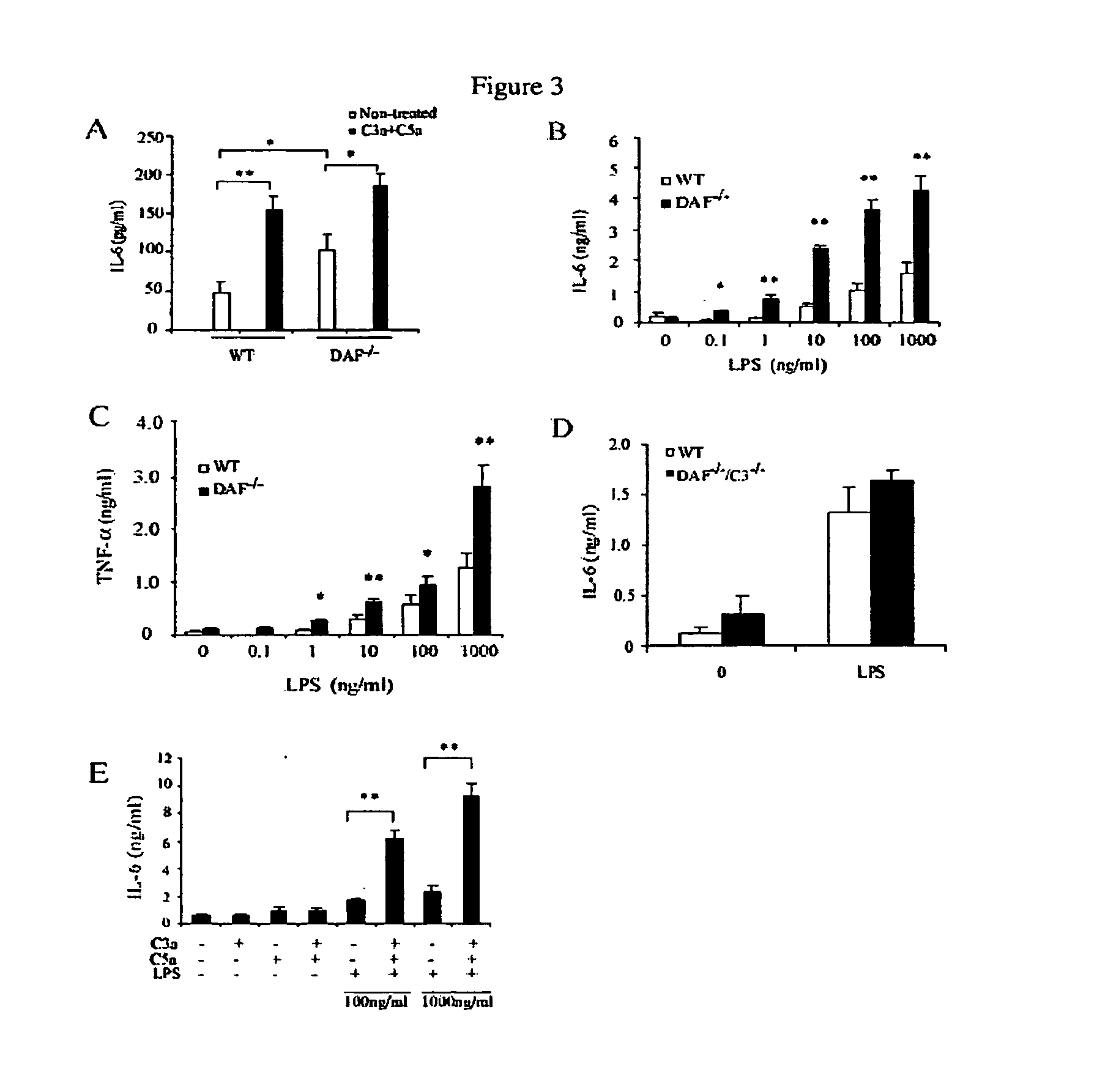Regulation of TLR Signaling by Complement
a complement and signaling technology, applied in the field of complement signaling regulation, can solve the problems of tissue injury and the potential of the complement system to be extremely damaging to the host tissue, and achieve the effect of preventing a toll-like receptor (tlr) dependent inflammation
- Summary
- Abstract
- Description
- Claims
- Application Information
AI Technical Summary
Benefits of technology
Problems solved by technology
Method used
Image
Examples
example 1
EXAMPLE 1
DAF− / − Mice were Hyper Responsive to LPS Challenge
[0092]DAF is a LPS-binding protein, thus, the initial objective was to determine if DAF might play a role in LPS signaling in vivo. To achieve this goal, C57BL / 6 wild-type and DAF− / − mice were challenged with a sub-lethal dose of LPS (20 mg / kg). DAF− / − mice developed more severe symptoms of endotoxin shock than wild-type mice (lack of activity, raised fur and hunched back posture). Consistent with this observation, plasma concentrations of IL-6, TNF-α and IL-1β were strikingly elevated (P− / − mice than in wild-type mice at 1 and 3 hours after LPS challenge (FIG. 1A-1C). Plasma IL-6 and IL-1□ levels remained significantly (P− / − mice at 1 or 3 hr (FIG. 1D). Conversely, we found that plasma IL-12p40 concentration was lower in DAF− / − mice than in wild-type mice (FIG. 1E).
[0093]Similar increases in plasma IL-6, TNF-α and IL-1β concentrations 3 hr after LPS challenge were observed in Balb / c DAF− / − mice (FIG. 1F), demonstrating tha...
example 2
EXAMPLE 2
Increased Complement Activation was Responsible for the Altered LPS Response in DAF− / − Mice
[0095]LPS is an activator of the alternative and lectin pathways of complement. Using activated plasma C3 fragments as a measure, a significantly (p− / − micewas detected compared to the wild-type mice at 1 and 3 hours after LPS injection (FIG. 2A). This result suggested an important role of DAF in preventing LPS-induced complement activation in vivo. To test the hypothesis that changes in LPS-induced cytokine production in DAF− / − mice were caused by increased complement activation, the LPS responses of DAF− / − / C3− / − mice were examined. As shown in FIG. 2B, increased plasma IL-6 and decreased IL-12p40 concentrations in DAF− / − mice. However, similar changes in cytokine production were not observed in DAF− / − / C3− / − or C3− / − mice (FIG. 2B). Thus, changes in LPS-induced cytokine production in DAF− / − mice were completely dependent on complement. Furthermore, the phenotype of altered LPS-indu...
example 3
EXAMPLE 3
Altered LPS-Induced Cytokine Production in DAF− / − Mice Involved Increased NF-KB and Mapk Signalling
[0099]TLR4-induced inflammatory cytokine production involves NF-kB activation. It was found in the present set of experiments that LPS induced a more rapid and robust NF-kB activation in the spleens of . DAF− / − mice than in wild-type mice (FIG. 4A-4C). Increased phosphorylation of the NF-kB inhibitor IkB-β was detected at 15 minutes and 30 minutes after LPS stimulation in the spleens of DAF− / − mice (FIG. 4A, 4B). Correspondingly, we found that total IkB-β levels in the spleens of DAF− / − mice were significantly decreased at 60 minutes after LPS stimulation (FIG. 4C). Thus, altered LPS-induced cytokine production in DAF− / − mice was correlated with increased activation of the NF-kB pathway. To directly test the involvement of NF-κB, we transfeceted RAW264.7 cells with an NF-κB luciferase reporter gene and studied the possible synergistic activation of NF-kB by LPS and C5a. FIG. ...
PUM
| Property | Measurement | Unit |
|---|---|---|
| anti-microbial resistance | aaaaa | aaaaa |
| vascular permeability | aaaaa | aaaaa |
| concentration | aaaaa | aaaaa |
Abstract
Description
Claims
Application Information
 Login to View More
Login to View More - R&D
- Intellectual Property
- Life Sciences
- Materials
- Tech Scout
- Unparalleled Data Quality
- Higher Quality Content
- 60% Fewer Hallucinations
Browse by: Latest US Patents, China's latest patents, Technical Efficacy Thesaurus, Application Domain, Technology Topic, Popular Technical Reports.
© 2025 PatSnap. All rights reserved.Legal|Privacy policy|Modern Slavery Act Transparency Statement|Sitemap|About US| Contact US: help@patsnap.com



